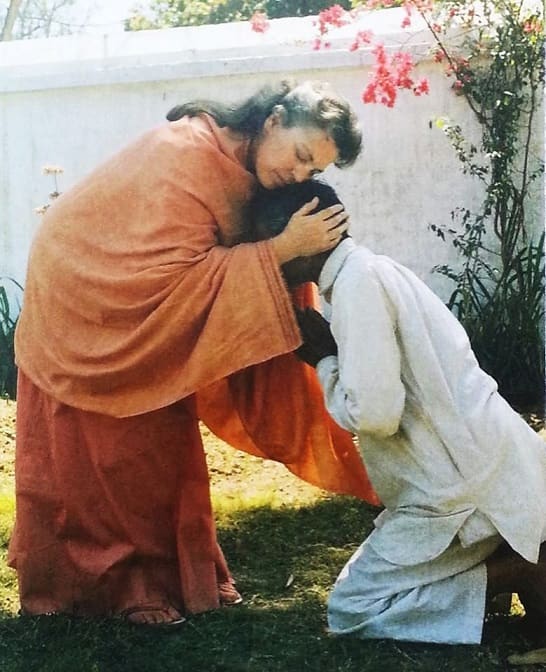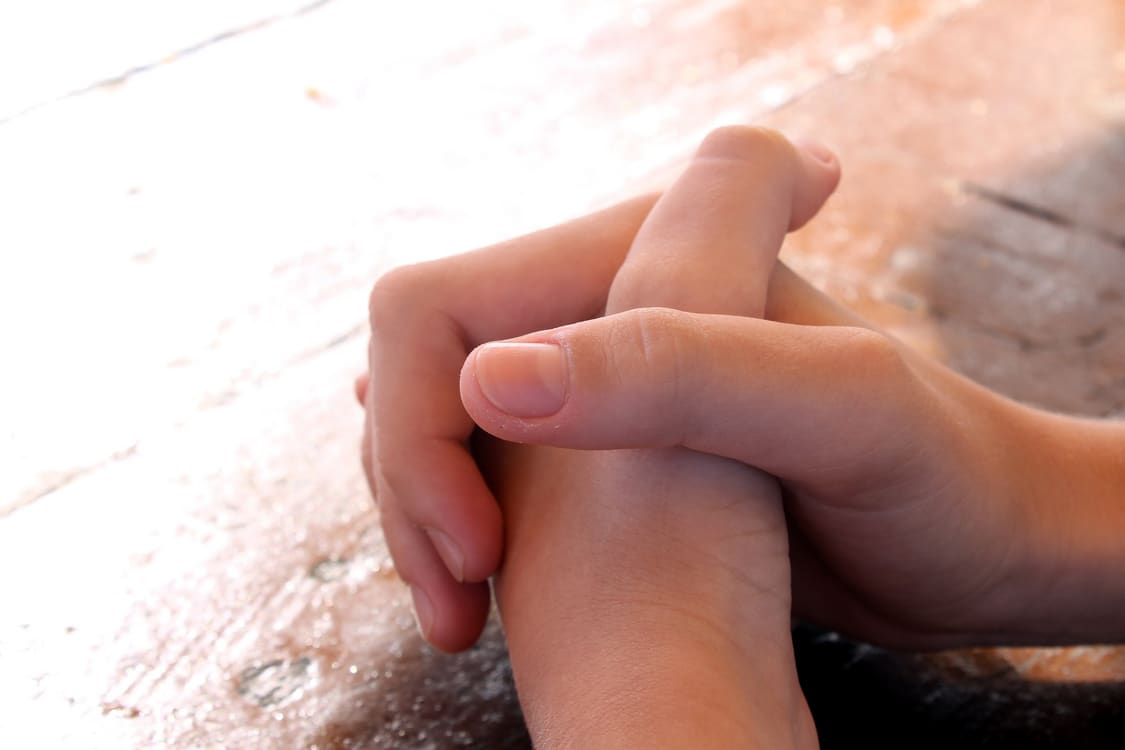Brother Tyagananda on Effective Parenting from Self Realization and Yogoda magazine
In the following talk published in the YSS magazine, 1992 (4th quarter), Brother Tyagananda gives invaluable advice on lovingly communicating and lovingly disciplining the children. This page contains only the first half of the talk, second half will be shared with you later on.
Please note: The Brother Tyagananda who gave this talk is probably not the same Brother Tyagananda who is currently known to many devotees as the minister of SRF Fullerton Temple. This article was published in 1992 and according to my little research it is very likely that there was another Brother Tyagananda in SRF during that time.
Dear Indian devotees, please note that the title ‘Brother’ is equivalent to the title ‘Swami’.
Effective Parenting
A Spiritual Approach
(Oct-Dec 1992, YSS Magazine)
by Swami Tyagananda Giri
Condensation of a talk given to parents and Sunday school teachers at Self-Realization Fellowship Temple, Encinitas
It is no small matter of concern that children today, and their parents, face tough challenges. We read news report upon news report about the problems facing young people: gang violence, drug abuse, sexual promiscuity, even suicide. But the “how-to-live” teachings of Sri Sri Paramahansa Yogananda give spiritual understanding to help deal with even the most difficult circumstances—including the formidable challenge of providing a wholesome environment where-in children can grow into happy, balanced, emotionally and spiritually mature individuals. The essence of Paramahansaji’s guidance on parenting is loving communication and loving discipline. Together, these two skills have the power to create a strong sense of family closeness that can go a long way toward counteracting the negative influences children are exposed to in contemporary society. Consider the following report of a study conducted at the Search Institute in Minneapolis:
Family Closeness actually fortifies children with an inner resistance to the problems of life…
We polled more than 8,000 children and 10,000 parents, and found that adolescents in a close family unit are the ones most likely to say no to drug use, premature sexual activity, and other anti-social and alienating behavior. They are also the ones most likely to adopt high moral standards, develop the ability to make and keep friends, embrace a religious faith, and involve themselves in activities that help others.
The essence of Paramahansaji’s guidance on parenting is loving communication and loving discipline.

A close family unit—what do we mean by that? It is a family in which the love expressed between parents and children creates a deep bond of trust and security, and makes the home a place of warmth and refuge.
Communication: Foundation of Family Closeness
“From our study,” the the above-cited article continues, “it became evident that families grew close through good communication, a goal many teens and their parents say they want to achieve.” Communication does not mean just talking. It means cultivating a rapport, an understanding. Sri Sri Daya Mata has said: “It is important to try to understand the child’s point of view, to see things as the child sees them.” In a way, the parent is like a teacher sent to a foreign country: To teach effectively, the instructor has to learn as much as possible about that culture—not only the language, but, more importantly, its underlying worldview and values. Without this, there will be no real understanding of the students or of the way in which the teacher’s own communications are being interpreted—even if the instructor has a good working knowledge of the language. Likewise parents should try to understand the worldview and inner needs of their children.

Try to remember yourself as a child. Take an hour alone, sit down and recall your salient feelings. Reminisce with your siblings or spouse, or look through an album of photos from your childhood, to help you recapture what it felt like to be a child. Children’s needs are different from adults’—not only physically but emotionally— and it is a mistake to talk or listen to a child in the same way you might interrelate with an adult.
Children’s needs are different from adults’—not only physically but emotionally— and it is a mistake to talk or listen to a child in the same way you might interrelate with an adult.
In his book, Between, Parent and Child, the famous child psychologist Dr. Haim Ginott tells a story that helps to explain some of the unique aspects of communicating with children. A mother took her young boy to his first day at kindergarten. The youngster looked over some student paintings tacked up on the wall and said, “Who made these ugly paintings?”
Naturally, his mother was embarrassed. “It’s not nice to call the paintings ugly,” she said. But the teacher, who understood the meaning of the question, answered, “Here it doesn’t matter if you paint pretty pictures. You can paint ugly pictures if you want.”
Then the child, picked up a broken fire engine and asked in an accusatory tone “Who broke this fire engine?” Again, the mother didn’t understand. “What difference does it make to you who broke it?” she asked. “You don’t know any of the children here.” But the teacher, who understood, answered, “Toys are for playing. Sometimes they get broken. It happens.”
The child smiled a big smile, waved good-bye to his mother, and happily went over to the teacher to start his first day at school. His interview with the teacher had given him the assurance he needed: “This lady is pretty nice. She doesn’t lose her temper when you paint an ugly picture or accidentally break a toy. I can stay here. It’s safe.”
Establishing Rapport
The foregoing story illustrates a rapport that goes deeper than mere talk. How to develop that rapport? To begin with, learn how to listen. This is nowhere so vital as with children.
If you have ever had the privilege of being greeted by our Sanghamata, Sri Sri Daya Mata, you know the real meaning of listening. It consists of absolute and total attention. Despite the incredible demands on her schedule, when Daya Mataji greets a member of Guruji’s spiritual family her attention is wholly with that soul. You don’t feel that anything else is competing for her time; you are the only one in her world at that moment. In that same way, each parent should be with his or her child for at least a small part of each day.

“Cultivate a rapport with children while they are young,” Daya Mataji tells parents, “so there will be a parent-child communication when they ore older.” One of the obstacles to establishing that rapport is that we tend to take for granted the people with whom we live in close contact—for example, our children. It is all too easy for them to become merely part of the “landscape,” so to speak—objects you stumble over as you go through your everyday routine of getting things done: shaving, getting dressed, fixing meals, cleaning house, getting to work on time. This is human nature, but it’s also a cause of alienation and insecurity.
A time should be set aside each day when all distractions and cares and troubles are put aside: “This time belongs to my child, to look into his eyes and focus in his heart and see what’s going on there, and let him know I’m here for him.”
Parents should ask themselves in all honesty: “How often are we actually communicating with our children? How often are we not just in their presence, but truly with them?” A time should be set aside each day when all distractions and cares and troubles are put aside: “This time belongs to my child, to look into his eyes and focus in his heart and see what’s going on there, and let him know I’m here for him.” The child can feel that attention. He knows his mother isn’t thinking about dinner or the laundry or the mess he made on the living room rug; his father isn’t thinking about work or football or washing the car. The concentration is on him. He feels a rapport with his parents; he feels loved.
Prayertime and Storytime
Bedtime stories and prayers are excellent media for parents to cultivate rapport with their little ones. I recall what a treat it was to have my father sit on my bed and tell a story, whether it was of “cowboys and Indians” or from heroic mythology, or something else he knew. I also remember my mother coming in for bed-time prayers. These were times of security and comfort.

“Master taught that there should be regular periods when parents and children come together for prayer and meditation,” Daya Mataji tells us. Now, parents should be realistic in how long they expect their children to meditate. Just because children can assume the lotus posture when they are three years old doesn’t mean they are accomplished yogis! Teach them simple prayers, in language to which they can relate. Sit on the bed with the child while he talks to God, then suggest, “Now, let’s look at the spiritual eye for just a moment and feel God’s response.” The period of time should not be long, perhaps only fifteen or thirty seconds in the beginning. Whatever the length, it should be well within the reach of the child, something he can enjoy.

For storytelling time, there are numerous books that contain entertaining yet instructive and spiritually inspiring stories. The Bible or the epic scriptures of India are good sources…
For storytelling time, there are numerous books that contain entertaining yet instructive and spiritually inspiring stories. The Bible or the epic scriptures of India are good sources, although the language used should be within the child’s comprehension level. I once gave an Easter service for Sunday School children on “Jesus the Winner.” From that viewpoint, he became very much of a hero to which they could relate. “Mejda” which recounts incidents from the childhood of our own guru, Paramahansaji, is another excellent source of inspiring stories, as is Autobiography of a Yogi—although, again, convey it in language that the child will understand.

Child Discipline — Paramahansaji’s Example
Discipline is a particular form of communication that is exceedingly important in effective parenting. A little story will help to illustrate several characteristics of our Guru’s discipline. Sri S. K. D. Banerjee, an Indian devotee who was one of the students at Guruji’s residential boys’ school in Ranchi while the master was there, recalls:
Under the direct supervision of Guruji, we were trained to keep our clothes, beds, and rooms quite clean and orderly. Guruji was very strict in this regard, and it was impossible for any student who did anything wrong to escape his notice. However, I do not remember a single occasion where he was found rebuking or chastising a student. I remember one day payas [rice pudding] had been prepared in the kitchen for the students, and I had accompanied a group of students who had gone to the kitchen to assist in the cooking. The cook had a soft corner in his heart for me, and he stealthily gave me a bowl full of payas, which I gladly consumed! Later on, when all the students assembled to take the evening meal, payas was served. Paramahansaji was also present. When the students started acha-man [traditional ritual sipping of water prior to one’s meal] Paramahansaji smilingly forbade me to do it. All started taking the payas, but I, with a bowl full of payas in front of me, remained inactive. After a moment, Paramahansaji looked at me again, still with a smile on his lips. He then asked me if I had taken payas before. It was out of the question to tell a lie. I nodded my head, and then he asked how I could dare to offer to God the payas which I had already tasted.
For some time he remained silent, then he again looked at me smilingly and said, “Very bad.” I started weeping and felt extremely miserable.
Discipline should never be carried out in anger… When you feel your temper rising, delay responding to the child. Bite your tongue, grit your teeth, dig your fingernails into your leg, count to ten - whatever is necessary.
There was no physical force, there was no rebuking, there was no loss of temper, there was no big commotion. But there was discipline. And the standard of conduct expected of the child —who was nine or ten years old at the time, perhaps younger —was extremely high. He was expected to know—and indeed he did know—that it was wrong to quietly accept an extra portion of the treat intended for the whole group of boys, and especially so before the food had been symbolically offered to God.
Paramahansaji’s criticism was directed toward the behavior, not the child. He said, “Very bad.” He did not say, “Bad boy.” Many people who were subjected to the wrong kind of discipline become aware in their adulthood that they had taken this message to heart: “I’m a bad person; I am not worthy of being loved.” Take care not to give that destructive message to your children.
Also, we see that Guruji’s discipline was given in a very calm and loving manner. A vital point: Discipline should never be carried out in anger. When the child’s behavior causes your temper to flare up, the best thing to do is something that is something that in most cases we very much teach against: suppression. Suppression is bad, but violence is even worse. When you feel your temper rising, delay responding to the child. Bite your tongue, grit your teeth, dig your fingernails into your leg, count to ten - whatever is necessary. Make it clear to the child, “You are misbehaving and we will have to discuss it further. I’ll see you in a half hour” (or however long the parent needs to deal with his own anger). Then, go off by yourself and work it out: go for a walk, do some deep breathing, pray, meditate. When calmness returns, go back to the child and discuss the situation: “This was your action, and now I am going to explain to you the consequences.”
This brings us to another aspect of Paramahansaji’s discipline illustrated by the above-cited story: He did not deal in terms of punishment, but in consequences of behavior. God does not punish us; the world does not punish us; but our behavior has consequences: We punish ourselves when we disregard the laws of right action. This is the lesson the child needs to learn. Parents should never feel guilty when it is necessary to impose discipline, for if they do not teach their children this immutable truth, the world will surely do it for them. When discipline is necessary, parents should always seek to convey to the child: “I love you and I’m concerned for you. This kind of behavior is harmful to you. It’s not that I consider you bad, or that I’m angry, or that I want to hurt you because you upset or inconvenienced me. It’s that each of us has to learn that this kind of behavior brings a particular consequence.” Far better for children to learn at the loving hands of their parents than to go unprepared, naive and foolish, into an unsympathetic world to learn their lessons in the “school of hard knocks.”
“Self-Realization,” Paramahansaji said, “is a philosophy of living: right meditation, right thinking, and right living. Bring up your children in this philosophy. Don’t pamper them, or teach them by wrong example to cater to their bodies and harmful desires; give them good training. Why enslave them in delusion? Give them true freedom by keeping their lives simple and cultivating in them inner peace and happiness.”
(To be continued in next Yogoda Satsanga annual-series booklet)
The 2nd part of this talk/article must have been published in the next issue of the YSS magazine. As of now I do not have that issue. When I get it, I will surely share it. If you have it please let me know.
